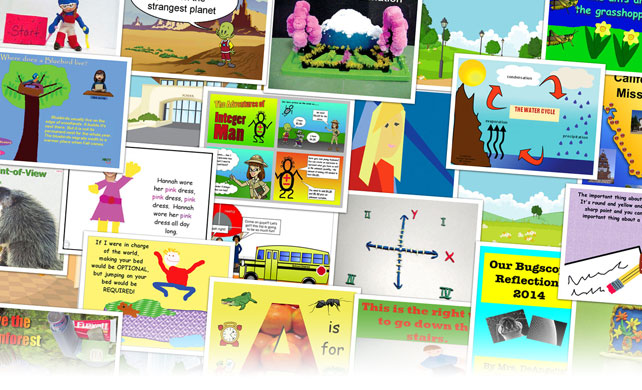

“The illiterate of the 21st century will not be those who cannot read and write, but those who cannot learn, unlearn, and relearn.”
—Alvin Toffler
While extraordinary digital natives may be the current rage in the media, our classrooms are also full of students who are not prepared for work at grade level and are not interested in school. Many have disadvantaged backgrounds, some need help learning even basic skills, and others are bored because they aren’t being challenged.
These students generally don’t learn from sitting still, hearing a lecture, or reading a textbook. While direct instruction may be the least time-consuming way to provide students with information, it doesn’t help these groups of students learn. If we listen to these students’ complaints, or research our referrals for them, it isn’t too hard to discover that they are not engaged.
How do we engage them? Not by changing the content of what we teach, but by differentiating the process with which we teach that content. The ability to read and write will remain essential for effective communication and success in our modern world; however, new literacies like information, media, and technology are becoming increasingly important.
We need to teach academics in a way that embraces both traditional communication skills and new technologies, empowering students to make connections between what they are learning in the classroom to the world outside. We must transform our classrooms into learning environments that supply both rigor and relevance.
Surveys administered by the Pew Research Center show that “nearly six in ten teens (57%) say they edit and revise more when they write using a computer compared with when they write by hand” (Pew, 2008). If students are willing to work harder and take more risks simply because they’re using a computer, why not take advantage of the opportunity to engage and push the students to even greater successes than they’ve experienced in the past?
Many students spend their personal lives immersed in a sea of music players, phones, and gaming devices. Encouraging students to pull out and use their mobile computing devices in class, rather than demanding that they power them down, can help us boost engagement, improve basic literacy, and promote the development of advanced communication skills.
For example, you can ask students to text you a summary of a chapter they have read or even the main idea of a section of text. The 140–character SMS limit makes this a fun challenge. Students don’t need to know that research by Marzano, Pickering, and Pollack shows that summarizing is a key instructional strategy for improving student academic performance.
Students could also create mock social network pages for characters they are studying or elements on the periodic table. How might Socrates comment on a current YouTube video? How would Plato? These projects help give essential media and communication practice to students who don’t have access to technology outside of school.
Technology tools alone won’t transform our students into powerful thinkers and communicators. While many hard-to-reach learners struggle with basic literacy skills and need additional help with the 3 R’s, they also need learning experiences that help develop important 21st century skills like creativity, collaboration, critical thinking, and media-rich communication (the 4 C’s). The best part is that you don’t have to change or add to the content you are teaching! These skills are best gained during the process of learning.

Project-based Learning (PBL), which involves authentic real-world tasks, simultaneously builds both critical thinking and technology skills. As learners grapple with complex questions that don’t have a single correct answer, students must learn to analyze, evaluate, and apply knowledge as they develop organizational, leadership, innovation, and problem-solving skills.
What does PBL look like in the classroom? Let’s look at a typical state report. This often takes the form of a slideshow that shows a picture of the state map with the capital, a slide with the state song, the state bird, etc. The report contains information that can be located online in about a minute and is at the bottom of Bloom’s taxonomy.
A project-based approach still requires students to know information about their state, but asks them to apply it or analyze in an authentic way. What could a problem or task for a state report PBL project look like? There are many right answers!
For example, you might ask students to take the role of a member of the state board of tourism and create an advertising campaign to encourage others to visit a state. A technology product could be a presentation, brochure, video, or website that would include information about the state’s unique history, geography, ecology, economy, and leisure opportunities.
You might ask students to take the role of a member of a family where one parent has been offered a very important, high-paying job in another state. The task would be to craft an argument about whether or not the family should move.
How much does housing cost? Do recreation options there match family interests? What makes a state unique? What makes life in Massachusetts different from Arizona? Why do some families prefer to live in the South, while others prefer life in the West?
Authentic projects tend to be complex. Rather than spending time hunting for the correct answer, students spend their time asking lots and lots of questions. Once students begin asking questions about the topics you are exploring in your classroom, they’re hooked! You have engaged them!
Much of student technology and media use, both inside and outside of school, is centered around the passive consumption of entertainment media. To prepare our students for life after the classroom, we need to require them to become media producers. If we want classrooms full of active learners who work hard to solve problems and build meaningful projects, we need to provide our learners with tools and situations where the student “tells the computer what to do,” not the other way around (Johnson, 2010).
To ensure that both advantaged and less-advantaged students in our classrooms can compete in the techno-centric global society, our classrooms must engage them and provide them with high-level skills they can use in the world outside of the classroom. Without a rich and powerful educational experience, these students will have a harder time succeeding now and in the future.
Marzano, R. J., Pickering, D. J., & Pollock, J. E. (2001). Classroom Instruction that Works: Research-Based Strategies for Increasing Student Achievement.
Alexandria, VA: ASCD.
Pew Internet and American Life Project. (2008) Writing, Technology, and Teens.
Washington, DC: Pew Research Center.
http://bit.ly/f7ses
Johnson, Doug. (2010). Entertainment vs. Engagement: Why it’s Imperative.
Bombay: TedxASB
http://bit.ly/jsDD0W
Lankshear, C. & Knobel, M. (2006). New Literacies: Everyday Practices and Classroom Learning.
Philadelphia: Open University Press.
Creative classroom ideas delivered straight to your in box once a month.

What can your students create?

Wixie
Share your ideas, imagination, and understanding through writing, art, voice, and video.

Rubric Maker
Create custom rubrics for your classroom.

Pics4Learning
A curated, copyright-friendly image library that is safe and free for education.

Wriddle
Write, record, and illustrate a sentence.

EDU ToDo
Interactive digital worksheets for grades K-8 to use in Brightspace or Canvas.
Topics